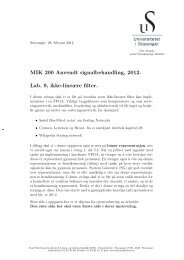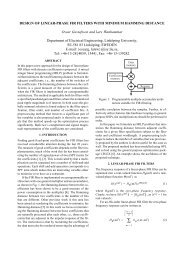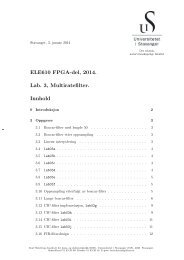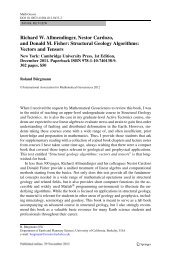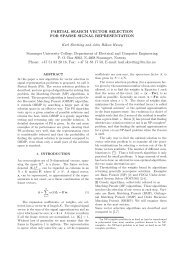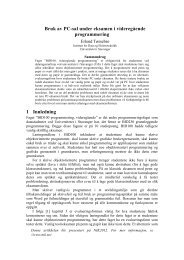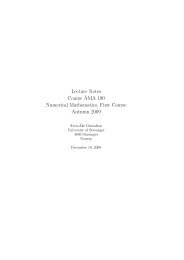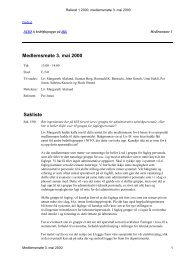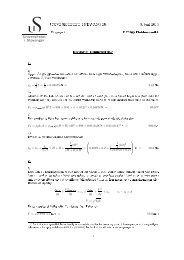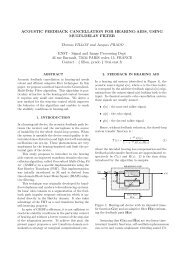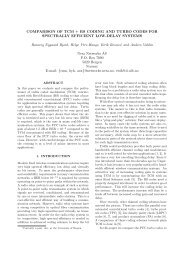MODELING OF LOW SALINITY EFFECTS IN SANDSTONE OIL ...
MODELING OF LOW SALINITY EFFECTS IN SANDSTONE OIL ...
MODELING OF LOW SALINITY EFFECTS IN SANDSTONE OIL ...
You also want an ePaper? Increase the reach of your titles
YUMPU automatically turns print PDFs into web optimized ePapers that Google loves.
16 OMEKEH, EVJE, AND FRIISand substituting the expressions for c 1 (x) and c 5 (x), found from the equations (82), (85), and (87)above, in B 3 , we arrive at the following nonlinear equation in the variable x (in light of (12) and(52)):(89) x + g(x)h(x) − En+1 3 = 0,where(90) g(x) = M c CEC √ γ ca K cana√ x,and(91)h(x) = 2K cana√γca√ x +γ na√ϕsn+1+ K mgna√γmg(( √ xEn+11√ x + ˜C1 (E n+1√− ˜C 3 (E3 n+1 − x)√ + x3 − x))( ˜C 3 (E3 n+1 − x)) 2+ 4E5n+1xCurrently, we solve the nonlinear equation (89) by using the matlab routine fzero.5.4. Numerical treatment of the selectivity factors. A number of authors have shown thatthe selectivity factors may vary with brine salinity and concentrations in a complex way. See [4, 20]for examples of such relations. For the MIE model represented by (6) we see that the selectivityfactors we have to deal with are K cana and K mgna .linearly between two extreme values of selectivity factors Kmgna LS and K HSsalinity brine concentrations B LSs(92)K mgna (B s ) =K cana (B s ) =where Brine salinity B s is given by).For ease of computations we interpolatemgna, corresponding to lowrespectively:and high salinity brine concentrations B HSs( BHSsBsHS( BHSsB HS s− B s− B LSs− B s− BsLS) (Kmgna LS Bs − BsLS+B HS − B LS)K LScana +ss( Bs − B LSsB HS s− B LS s)K HSmgna)K HScana,(93) B s = ∑ iC i Z i .Note that the selectivity factors are updated at each grid block for every new time step by usingvalues of the brine salinity from the previous time step. We refer to Appendix A for specific choicesof BsLS and BsHS as well as Kmgna, LS Kmgna HS and Kcana, LS Kcana.HS6. Numerical investigations6.1. Generally. The core plug under consideration is initially filled with formation water whichis in equilibrium with the ions on the rock surface. Initially, the core plug has a given wettingstate, termed here as high salinity wetting state, which is completely described by its relativepermeability functions, see Section 3.1. However, when flooding is done with a brine with ionconcentrations different from the formation water, the invading brine creates concentration frontsthat move with a certain speed. At these fronts, as well as behind them, chemical interactionsin terms of a multiple ion exchange process will take place. It is expected that the water-rockinteraction then can lead to a change of the wetting state such that more oil can be mobilized.Main focus of this paper has been, motivated by previous experimental research as described inSection 1, to build into the model a mechanism that relates wettability alteration (towards a lowsalinity wetting state) to desorption of divalent cations from the rock surface. The purpose ofthis computational section is to gain some general insight into the behavior of this model, whenperforming water flooding with different brines. Obviously, we are particularly interested to seewhether we can discover any ”low salinity effects” on the oil recovery curves produced by thenumerical model.



